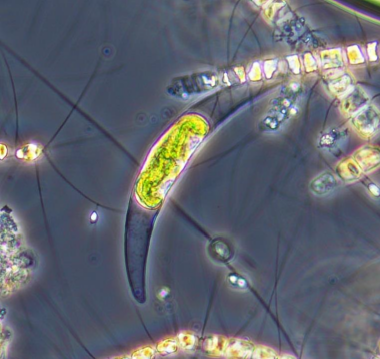Phytoplankton samples were collected on March 19, 2025 at Bullock Reach and analyzed in the laboratory shortly after collection.
It was sunny and cold on this day. The water temperature was 6.6 degrees Celsius, and jellyfish were observed. Sonde data was not recorded.
The qualitative tow net sample had a moderate to long filtration time and the filtrate was cloudy and dark brown with a large amount of sediment.
The analysis of the quantitative whole water sample revealed a total of 4,744,000 cells/L. The microflagellates were found at 86,000 cells/L. The most predominant phytoplankton genera were Leptocylindrus spp. at 2,918,000 cells/L, Chaetoceros spp. at 1,474,000 cells/L, and Skeletonema spp. at 144,000 cells/L.

Pyrocystis spp., shown here in a 200x phase contrast micrograph, are non-motile, tropical, epipelagic marine dinoflagellates. They exhibit bioluminescence, which means emitting light through a chemical reaction, when they are disturbed or agitated. This is an unusual defense mechanism against predation which aims to startle grazers who would otherwise eat them.
